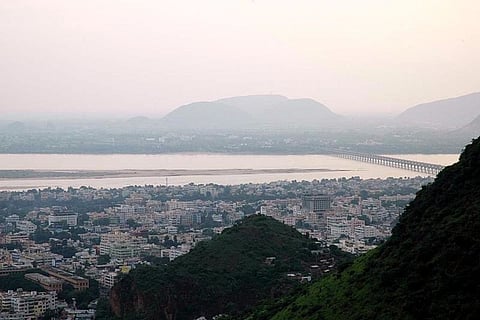

On Tuesday, as heavy rains poured down on many parts of Telangana and Andhra Pradesh, Siva Sankara Rao, a middle-aged man living in Vijayawada, was reportedly watching TV, when the roof of his house came crashing down on him. This happened after boulders rolled down a hill following a landslide and fell on his house. He died, buried under the rubble of his house. His wife Sujatha suffered injuries. District officials have given Sujatha a compensation cheque for Rs 4 lakh within two days of her husband’s death. Siva Sankara Rao was one among at least eleven people who have died in rain-related incidents in the state recently. In Telangana, at least 50 people have died because of the unprecedented, heavy rains triggered by a deep depression in the Bay of Bengal.
The landslide, however, was not unprecedented at all. Similar incidents have been reported in the hilly regions of Vijayawada city several times in the past during the monsoon. While many of them are harmless incidents resulting in minor damage or injuries, a few, like Siva Sankara Rao’s accident, are fatal. Siva Sankara Rao’s house is located near the Nalugu Sthambhala Centre in the hilly area of Vidyadharapuram, which is one of the areas known to be at risk of landslides, along with Christurajapuram, Kothapeta and Moghalrajpuram, according to CPI(M) state secretariat member Chigurupati Baburao. According to Baburao, over the past ten years, around 20 people in Vijayawada residing in hill slope regions have lost their lives in landslide incidents.
Different solutions have been proposed by the Vijayawada Municipal Corporation (VMC) in the past, according to reports, including setting up of shelters for residents of at-risk areas during monsoon, construction of retaining walls to stop the boulders from crashing onto their homes, and relocating the residents from the hill slopes to government housing projects.
The process of identifying the locations at risk of landslides has been completed by the VMC’s engineering and town planning departments, along with police and revenue officials.
Baburao says that a few retaining walls, which have already been built, are about to collapse. They must be repaired, and proper retaining walls must be constructed, he says.
However, constructing retaining walls for these locations is not feasible, say VMC officials.
“Constructing a retaining wall will turn out to be too costly. We have already identified some vulnerable places where landslides are occurring. But in each spot, for (the protection of) two houses, we have to spend almost Rs 50 lakh for the construction of the retaining wall. Even if each house costs around Rs 10 lakh, for two houses worth Rs 20 lakh, we have to spend almost Rs 50 lakh to protect them,” a VMC official told TNM.
With retaining walls being deemed infeasible, the VMC is looking to relocate the residents to government housing projects.
According to Baburao, the residents of the hill areas have been demanding land rights and regularisation of their hill-slope houses for a long time. “There are nearly 2 lakh households living in the hill areas of the city, in 15 divisions. So far, only around 25,000 families have received regularisations forms, says Baburao. He goes on to explain that even these papers are ‘D -form Pattas’, which do not give complete ownership rights to the residents, like the freedom to sell the land or use it as collateral for bank loans. The hill-slope residents have been demanding title deeds for the land on which their houses are built, with complete rights.
While Baburao says that the few residents living in houses identified to be at risk of landslides must be relocated, the VMC official claims that many of these residents are reluctant to move out, and continue to demand land rights along with the other hill-slope residents. “Because mentally they have decided to stay there, we have to convince them to move,” he says. The VMC official also claims that land rights are a major issue in the local body elections, which means local leaders affiliated with various political parties are also reluctant to suggest that the at-risk residents be relocated.
“It is better to vacate them (at-risk residents) and give them houses under JNNURM (Jawaharlal Nehru National Urban Renewal Mission) or APTIDCO (Andhra Pradesh Township And Infrastructure Development Corporation) houses,” the VMC official says. He adds that around 3,000 houses have already been completed under JNNURM. They are at the final stage. Houses are built, roads and infrastructure are completed, we are waiting for power supply,” he says.
Construction of JNNURM housing in the city has been delayed for a long time, and some of these projects are located in areas like Jakkampudi, which are far from the central parts of the city where many of the hill-slope residents currently live and work.